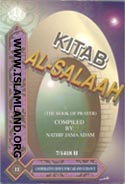Kitab Al-Salaah (The book of Prayer)

The
Prayers Of The Two Feasts
These are:
- The prayer of the Feast of Breaking the Fasting of the month
of Ramadan (known as 'Idul-Fitr Prayer).- The prayer of the Feast of Immolation (known as 'Idul-Al-Adha
Prayer).We shall now discuss the mode of performing each of these prayers.
Idul-Fitr Prayer
Upon completion of the obligatory fasting of the blessed month of
"Ramadan", Muslims celebrate the occasion of breaking the Fast by
festive celebration which last for three days. The Muslims welcome the
feast with prayer and private supplications and by giving praise to
Almighty Allah (subhanahu wa ta'ala). This prayer is performed as
follows:
- On the first day of Shawwal (the month that follows Ramadan)
the person goes to the 'id Mosque or praying ground having undertaken
the following recommended acts:
- Taken total ablution (Ghusl).
- Dressed in the best of clothes (preferably new clothing).
- Assumed a breaking of the Fast by eating at least a few
pieces of dates. This is in accordance with the tradition of the
Prophet (peace be upon him), and an odd number is preferred i.e. 3, 5,
7, 9 and so on.- It is the practice (Sunnah) to head to the 'id praying
center by walking. Upon arrival at the place of prayer the person sits
and waits for the prayer to begin.- After about 20 minutes from clear sun rise, the imam
stands up for the prayer and loudly signifies the entering into prayer
by reciting the "Takbiiratil lhraam" that is "ALLAHU AKBAR". The whole
congregation also follows suit by reciting the "Takbiiratil-lhraam".- As usual, with any other prayer, the person thereafter
comes up with the opening supplication known as "DUA AL ISTIFTAAH".- After that, the Imam says "ALLAHU AKBAR" 6 more times
and the congregation would follow likewise.- After completing the recitations of the words of
greatness which total up to seven, the Imam would then seek the
protection of Allah (subhanahu wa ta'ala) from the cursed satan in a
low voice by saying "AUTHU B'LJBILLAHI MINASH SHAYTANIR-RRAJIIM". He
would thereafter silently invoke Allah's name by saying:
"BISMILLAHI-R-RAHMANI-R--RAHIIM" and then recite "AL-FATIHAH" (the
opening chapter of the Holy Qur'an) in a loud voice. The followers
(congregation) would then say "Ameen" together loudly after the Imam
completes reciting the "Al Fatihah". Each follower would then recite
"Al-Fatihah" silently. It is recommended that the Imam thereafter
recites the whole of chapter 87 of the Holy Qur'an i.e. "SA BIHISMA "
(Glorified be the name of thy Lord, the Most high). The followers are
required to listen to the Imam's recitation.- The Imam then raises his hands up to the level of his
shoulders or ears performs "Rukuu" saying "ALLAHU AKBAR." 'Thereafter
he
raises his head up from bowing saying "SAMI'A ALLAHU LIMAN HAMIDA"
followed by the congregation saying "RABBANNA WALAKAL HAMD". The Imam
and the congregation thereafter proceed to prostration saying "ALLAHU
AKBAR".- After the prostration, the Imam would resume the standing
position for the second rakaat and the congregation would follow him up
accordingly.- Thereafter, the Imam would say "ALLAHU AKBAR" 5 times
and the congregation would perform likewise, and would recite the
private supplication between each "Takbiir" as already discussed in
point 4 above.- Then, the Imam recites "AL-FATIHAH" and for this second
rakaat it is preferred that he thereafter recites the whole of chapter
88 of the Holy Qur'an i.e. "Al-Ghasiya", (The Disaster) and the
congregation would listen attentively.- Thereafter, the Imam completes the Rukuu (bowing) and
Sujuud (prostration) positions in the manner already discussed and sits
back for the words of witness "At-Tashahud". Then, the Imam concludes
the prayer with the words of peace i.e. "ASSALAMU ALEYKUM WA
RAHMATULLAH" and of course, the entire congregation would follow the
Imam in all these acts as is the custom in all prayers.- After concluding the prayer, the Imam would climb the
pulpit to deliver the 'Festival Sermon', and starts the same with nine
recitations of "ALLAHU AKBAR" with the congregation saying after him
the same. After listening to the sermon, the congregation disperses.
Listening to the sermon is not obligatory but is recommended.
Idul-Adha Prayer
"IDUL ADHA", (Feast of Immolation) prayer is performed on the 10th
day of the 12th month of Islamic "Hijra" Calendar and is
performed exactly in the same manner as enumerated and discussed above
for the 'Idul Fitr Prayer.
